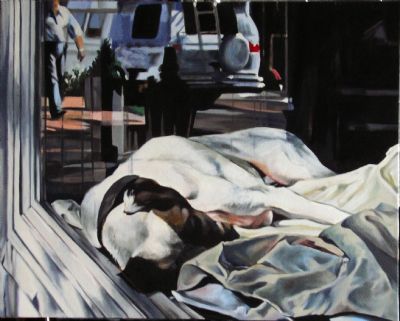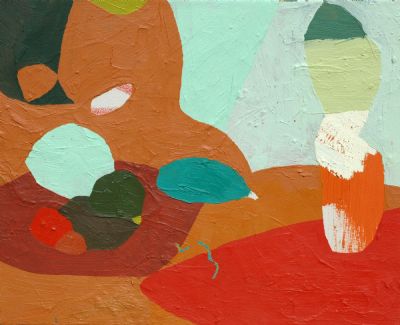Chicago Art Open—Democracy or Popularity Contest?
by Lara Bullock
As I looked out onto expansive Highway I-95 through the grease stain on the window of the Red Line, I was filled with skepticism; I was going to an art fair, specifically the Chicago Art Open. Not being from Chicago or having attended the Open before, I was expecting the usual: a tireless journey through a huge pavilion containing hundreds of artists with hundreds of artworks for sale; shameless, but necessary self-promotion. Artist Francesco Vezzoli captured my sentiment when he told Vanity Fair that “in terms of art fairs in general . . .I feel raped . . .It’s violent. It’s the artists deprived of any context. It’s fast food.”
However, when I arrived at a charismatic brick building, my hope began to rise. The Zhou B Art Center, where the event was held, looks abandoned from the outside. Some of the windows are half painted-over, making it seem as if the top floor is vacant. Bright red flags and a sign advertising a café, however, assured me that it was not. A similarly toned-down feeling permeated the whole experience, forcing my inner skeptic to brood outside the door.

Greyhound in the Window by Mei-Ku Huang at the Chicago Art Open |
|
The Chicago Art Open does belong to the family of the crowded art fair, but it is a distant cousin. While it features over three hundred Chicago-based artists at all stages of their careers, an intimate setting and an inclusive atmosphere give the Open a homegrown feel. In this sense, the Zhou B itself, founded by two Chicago artist brothers, is both an attractive and an appropriate venue.
The Chicago Art Open is hosted by the Chicago Artist’s Coalition, an organization founded in 1974 by artists and locals who wanted to create a better resource for those producing art in Chicago. The Open was created specifically as a way to showcase these artists in the community during Chicago Artist’s Month.
The show is not organized as a hierarchy but, on the contrary, student works are shown alongside professional work. When I inquired about how one can be considered for the show, CAC Executive Director Olga Stefan stated that “the prerequisites for being included in the professional show are to have had an exhibition history of at least two years, with a few professional shows, while for the student portion, one must simply be enrolled in a full-time art program.” Pretty democratic, if you ask me.
Further separating the Chicago Art Open from the capital-driven intimidation of most art fairs (though works there are, in fact, for sale) is the fact that it involves several events, including this year, a benefit featuring music from local band Graymail and dinner; a family day with art workshops for kids and parents; and a discussion entitled “The Role of the Artist as a Catalyst for Change,” featuring three panelists: artist Bernard Williams, Northwestern Art Theory professor Lane Relyea, and artist and SAIC professor Claire Pentecost.
The discussion’s topic was a crucial one for the Open. As panelist Relyea so astutely observed, the power of change possessed by artists projects a sense of responsibility in determining how such progress is utilized. As one example, Pentecost mentioned alternative space Mess Hall (located at 6932 North Glenwood Avenue in Rogers Park), which arose at a time when museums were seen as politicized public institutions. In relation to the establishment of alternative spaces that perhaps can be viewed as political acts on a small scale, Relyea also cited the more recent rise of apartment galleries and business-license-free public nonprofit spaces. Williams also pointed out murals as one of the last effective political voices on the streets; a movement that began in Chicago. These examples served as a potential contrast to the museum, which, it was suggested, may serve as either an obstacle in the way of art’s potentially revolutionary politics, or a gathering place for information, objects, and material.

Podscape by Amy Lemaire at the Chicago Art Open |
|
One of the first things I noticed about the show itself was the range of artistic styles and abilities. It felt liberating to see that a student could be accepted on a similar par with a professional artist. This is when I noticed the various acronyms attached to the labels. There were “PRO” (professional artist), “CAO Edition” (to indicate prints were available), and “CC.” Despite the egalitarian claims of CAC Director Stefan that the Chicago Art Open was created “to showcase the diversity and creativity in Chicago’s contemporary art scene, and allow that energy to be shown without judgment,” this year’s show featured a “Curators Choice” section. Am I the only one who sees a contradiction here?
The jurors included Julie Rodrigues-Widholm (Assistant Curator, Museum of Contemporary Art), Carl Hammer (Carl Hammer Gallery), and Jeanne Dunning (Chair, Art and Theory Department, Northwestern University). In order to assess the work, the jurors were shown a PowerPoint presentation of over 800 pieces. Hammer explained that “the decisions arrived at were well discussed between the three chosen jury members,” but admitted that he was “a bit disappointed by the jurying process” and felt that it “tainted the end results in a regretful way.” He went on to say, “when I arrived at the Zhou B. Center to view in person, for the first time, the actual works of art themselves, I was mildly horrified by some of [the] decisions.” For the judges to make their decisions without seeing the work in person reminded me of my experience seeing the Mona Lisa for the first time, and the surprise I felt at how small and understated it was.
Despite this significant procedural misstep, Hammer defends the show’s organizers who, he says, “in all fairness, did not have the ability to fairly present the actual works to us at the time we sat down to jury the show . . . due to limitations of space and the amount of work they received.”
Ultimately, I am glad that I attended the Chicago Art Open, and I am eager for the next one. It is not often that so many individuals in the art world (critics, theorists, artists, curators, gallery owners) come together to discuss their singular passion in such an inclusive setting. And as juror Julie Rodrigues-Widholm asserts, “It was a great opportunity to view the works of artists I’m not familiar with, and it is a testament to the vast number of talented artists we have in the city.”
For more, also see the MCA
images courtesy of the Chicago Art Open |